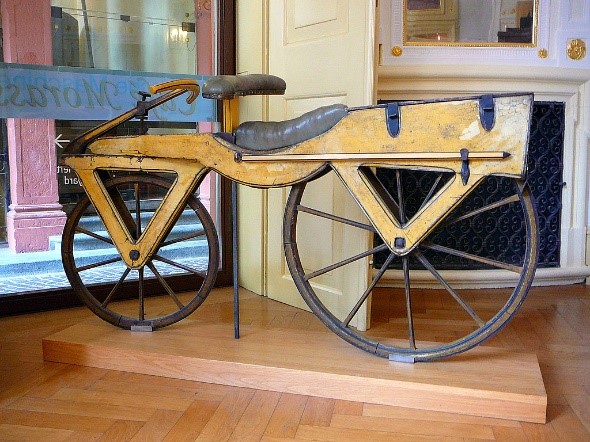Cycling, also called biking or bicycling, is the use of bicycles for transport, recreation, exercise or sport. People engaged in cycling are referred to as “cyclists”. “bikers”, or less commonly, as “bicyclists”. Apart from two-wheeled bicycles, “cycling” also includes the riding of unicycles, tricycles, quadricycles, recumbent and similar human-powered vehicles (HPVs).
Cycling
History
Vehicles for human transport that have two wheels and require balancing by the rider date back to the early 19th century. The first means of transport making use of two wheels arranged consecutively, and thus the archetype of the bicycle was the German draisine dating back to 1817. The term bicycle was coined in France in the 1860s, and the descriptive title “penny-farthing”, used to describe an “Ordinary Bicycle”, is a 19th-century term.
The concept was picked up by a number of British cartwrights; the most notable was Denis Johnson of London announcing in late 1818 that he would sell an improved model. New names were introduced when Johnson patented his machine “pedestrian curricle” or “velocipede,” but the public preferred nicknames like “hobby-horse,” after the children’s toy or, worse still, “dandy horse,” after the foppish men who often rode them. Johnson’s machine was an improvement on Drais’s, being notably more elegant: his wooden frame had a serpentine shape instead of Drais’s straight one, allowing the use of larger wheels without raising the rider’s seat. During the summer of 1819, the “hobby-horse”, thanks in part to Johnson’s marketing skills and better patent protection, became the craze and fashion in London society. The dandies, the Corinthians of the Regency, adopted it, and therefore the poet John Keats referred to it as “the nothing” of the day. Riders wore out their boots surprisingly rapidly, and the fashion ended within the year after riders on pavements (sidewalks) were fined two pounds.
The 21st century has seen a continued application of technology to bicycles: in designing them, building them, and using them. Bicycle frames and components continue to get lighter and more aerodynamic without sacrificing strength largely through the use of computer-aided design, finite element analysis, and computational fluid dynamics. Recent discoveries about bicycle stability have been facilitated by computer simulations. Once designed, new technology is applied to manufacturing such as hydroforming and automated carbon fiber layup. Finally, electronic gadgetry has expanded from just cyclo computers to now include cycling power meters and electronic gear-shifting systems.

Rules
These rules and cautions apply to racer participants but also some in recreational cycling. In a race, cyclists have specific places to stock up, but they can also do so on the go by moving to their team’s support car. Usually, a cyclist goes and brings it to the rest of the companions who are with him. From a certain point of the stage, it is no longer allowed to go to refuel. At the end of the race, when it is time for the sprint, the cyclist can not make a sudden change of direction in order to cover the opponent’s path with him close and may be disqualified, since it endangers the physical integrity of the opponent since they are traveling at very high speeds. It is important always to be aware of the route, and knowing the route is advisable, in order to avoid possible falls in more dangerous places and also not to cause a chain fall. Always wear protective gear, whether in competition or just in recreational cycling.

Equipments
The main element for practicing cycling is the bike of course. But since this is an activity that can be done in very rough terrain and in conditions slightly drawn to the human body, it is also recommended to use some protection elements.
Helmet: How could it not be you should not miss the helmet. This is obviously used to protect your head in case of fall, this being quite vital and not wearing the helmet pose a great risk to your health.
Protection Gloves: These serve to protect your hands in case of fall but also to improve the grip of the palm of your hand with the handlebar, covering them the same palm and not the fingers.
Clothing: The clothes of cyclists are also quite different from normal. What stands out is that they fit well to your body, thus reducing any unnecessary wind resistance and are also made with a material that regulates your body temperature and protects you from prolonged exposure to the sun.





